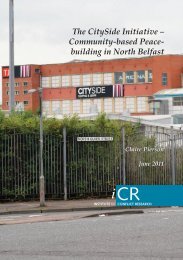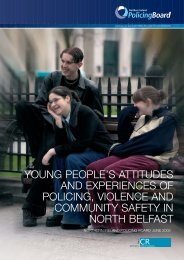Young People and Interfaces Report - Institute for Conflict Research
Young People and Interfaces Report - Institute for Conflict Research
Young People and Interfaces Report - Institute for Conflict Research
You also want an ePaper? Increase the reach of your titles
YUMPU automatically turns print PDFs into web optimized ePapers that Google loves.
YOUNG PEOPLE AND INTERFACES<br />
2. <strong>Young</strong> <strong>People</strong>, Public Space<br />
<strong>and</strong> the Interface<br />
2.1 <strong>Young</strong> <strong>People</strong> <strong>and</strong> Public Space<br />
Children <strong>and</strong> young people experience greater difficulties in laying claim to public space compared<br />
to adults (Leonard 2006a: 227; Childress 2004). This is in part related to the broader power<br />
structures in society, 8 <strong>and</strong> in a context in which groups of young people or ‘hoodies’ using public<br />
space are to be feared <strong>and</strong> demonised (Meek 2008: 1225; Kraack <strong>and</strong> Kenway 2002; Valentine<br />
1996). 9<br />
In the Northern Irish context due to perceived ‘threats’ from the ‘Other’ community, while it may<br />
make sense <strong>for</strong> teenagers from Catholic <strong>and</strong> Protestant communities to move around in relatively<br />
homogenous groups in terms of providing a sense of safety, this simultaneously feeds into <strong>and</strong><br />
(re)produces negative evaluations of the ‘Other’ (Leonard 2008: 484-485).<br />
Despite the negative connotations which have tended to have been rather pejoratively applied to<br />
young people’s use of public space, belonging to the ‘neighbourhood’ is an important part of the<br />
development of a sense of individual <strong>and</strong> communal identity. Close ties within a locality can give<br />
young people little reason to venture out of their area, <strong>and</strong> friends <strong>and</strong> family are an important<br />
aspect of local culture (Laughlin <strong>and</strong> Johnson 2011: 450).<br />
As such, belonging to the ‘neighbourhood’ or a variant of what Webster (2003) termed<br />
‘neighbourhood nationalism’ can provide a sense of belonging which in <strong>and</strong> of itself is not<br />
necessarily a negative development - where difficulties arise in the Northern Irel<strong>and</strong> context is<br />
where locality, ethnicity <strong>and</strong> territory intersect to powerful effect (Healy 2006: 107).<br />
2.2 <strong>Young</strong> <strong>People</strong> <strong>and</strong> <strong>Interfaces</strong><br />
As far back as 1998 BIP noted that children <strong>and</strong> young people in interface areas are particularly<br />
vulnerable to sectarian violence, intimidation <strong>and</strong> harassment, <strong>and</strong> can be exposed to such<br />
dangers on their way to school, going to the shops, or playing near the interface. Children’s lives<br />
can there<strong>for</strong>e be severely restricted by their difficulty in travelling out of their area or bringing<br />
friends into their own area (BIP 1998: 7).<br />
A survey conducted by Byrne et al. (2005) revealed that the fears of some young people in terms<br />
of going into areas dominated by members of the ‘Other’ community were not necessarily<br />
unfounded. 10 More than one quarter (26%) of young people had felt intimidated travelling to <strong>and</strong><br />
from their schools in North Belfast, while 51% had experienced an incident of violence <strong>and</strong>/or<br />
threatening behaviour while travelling to <strong>and</strong> from school. 11<br />
8 See, Arefi <strong>and</strong> Triantafillou (2005); <strong>and</strong> Laughlin <strong>and</strong> Johnson (2011).<br />
9 In Rosie Meek’s study in Engl<strong>and</strong>, young men reported hanging out on the streets or public places more than did young girls (Meek 2008: 127).<br />
10 The survey was of 2,486 young people aged between 14-17 in North Belfast.<br />
11 In 2004, 6% of young people surveyed as part of the <strong>Young</strong> Life <strong>and</strong> Times study felt they had been injured as a result of a sectarian incident (8% of<br />
males <strong>and</strong> 4% females) (ARK 2004).<br />
10






